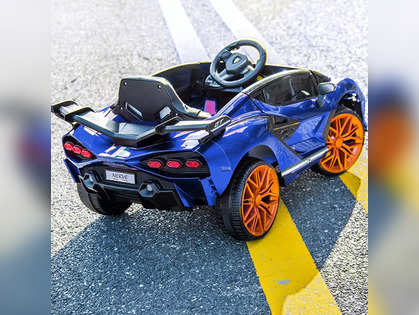Excellent Advice To Selecting Remote Control Childrens Cars
Wiki Article
What's The Battery Life Of An Electric Ride-On Kids Car?
It is important to understand the battery life of your electric ride-on vehicle for children and how long it takes to charge. This will ensure you get uninterrupted playtime. What you need to understand the battery type
The majority of electric ride-on cars for kids are powered by rechargeable batteries. They can be either Lithium-ion or lead-acid. Lithium ion batteries have a greater battery lifespan than lead acid and are charged faster.
Capacity of Battery -
The capacity of a battery can be measured in either watts-hours, or ampere-hours. Batteries with a higher capacity will provide longer playing duration before the need to recharge.
Run Time -
The time of a car's runtime is how long the vehicle is able to run continuously on only one charge of battery. It is affected by a variety of factors, including the capacity of the battery, strength of motor, terrain and the weight of a rider.
The run-time of electric ride-ons varies between 30 to 2 hours. But, lithium batteries that are high-capacity are able to provide longer run times.
Charging Time
The charging time is the amount of long it will take to charge a completely exhausted battery. Charge time may vary based upon the battery's capacity, specifications for the charger and charging method.
Charging times for electric ride on automobiles are generally between 8 and 12 hours. Some models have faster charging rates, particularly those with lithium ion batteries.
To ensure safety and long-lasting battery life, it's important to recharge the battery in accordance with the specifications of the manufacturer. Battery performance and longevity may be affected by charging too much or undercharging.
Charging Method Charging Method
Electric ride-on cars typically come with chargers that plug into a standard home outlet. Some models are equipped with rapid charging features or a smart charger that monitors the state of the battery and adjusts charging rates according to the condition.
To avoid battery damage or harm to electrical systems, ensure the charger with the ride on car is compatible with the charging port.
Additional Batteries
Certain electric vehicles allow you to purchase additional batteries or extra batteries to extend play time. It is possible to replace worn-out batteries with new ones that are fully charged, thus minimizing duration between sessions.
Understanding the battery life and charging times of an electric kids' car ensures that your child can enjoy uninterrupted playtime and fun adventures as they explore their surroundings. Regularly charging the battery, and following proper charging practices will help maximize battery life and performance. Take a look at the most popular Audi ride on car for blog recommendations including electric ride along car, race car toy, electric ride along car, ride on digger, toy car for car, race car toy car, remote control childrens electric cars, toy cars toy car, a toy car, kids electric cars and more. .

What Are The Reasons For Different Levels Of Skill For Electric Ride-On Vehicles?
The majority of electric ride-ons have multiple speed and control settings to cater for children of different capabilities and offer a safe and fun riding experience. Let's look at the reasons and how these features were put into place safety
Different children have varying levels of proficiency and confidence when it comes to driving in ride-on vehicles. The car's maximum speeds can be adapted to the child's skills, which lowers the risk of a collision or accident.
Beginners and younger children are better off using the lower speed setting as older children or those with more experience are more comfortable using the faster speeds.
Gradual Learning Curve -
The electric ride-on vehicle with the ability to adjust its speed allows youngsters to build their driving abilities gradually. Beginning drivers can gain confidence and become familiar with the controls, by starting at lower speeds.
As children gain driving experience, parents can accelerate the speed. This gives their child the feeling of accomplishment and progress.
Parental control -
Certain electric vehicles come with parental controls that permit parents to limit the speed of their child's vehicle. This feature allows parents to feel safe knowing that they can adjust the vehicle's speed or intervene, if needed, to ensure their child is secure.
Model-specific parental controls can include a limit on speed for remotes, remote emergency stopping buttons, and remote steering.
Flexibility
As children develop and grow, so do their interest and abilities. Electric ride-on vehicles that have multiple speed settings offer flexibility and adaptability to accommodate these changes as they happen.
Children may increase their speed as they get more experience and gain confidence. This will make for an exciting and challenging ride. For younger siblings or less experienced friends parents may decide to dial the speed down.
Customization -
Multiple speed settings allow for customizing and personalizing the ride experience according to individual preference and needs. Children can select the speed that is most comfortable for their level and preferred degree of excitement.
Some electric ride-on vehicles may come with additional control options such as variable braking or acceleration sensitivity. This enables the driver to customize their driving experience according to individual needs.
Overall, electric cars with different settings for speed and control offer a safe ride that is adaptable to different age groups capabilities, preferences, and abilities. These features help build confidence, growth in skills as well as fun, as well as allowing parents to be in control and intervene if necessary. View the top rated go here on ride on toys for blog advice including ride on toy, 2 seater electric cars, car electric ride on, electric ride on, childs electric ride on car, toy and car, toy the car, electric ride on, riding digger, two seater electric cars and more. .

What Kind Of Children's Remote-Controlled Cars Are There? What Are Their Advantages And Disadvantages?
Remote control vehicles for children Also known as RC or remote-controlled vehicles, come in a wide range of styles, sizes and price points. They're made to fit various budgets and tastes. Here's a breakdown of the pros and cons, and the sizes of remote-controlled children's cars.
Electric RC Cars – Batterie-powered remote-controlled cars that are suitable both for indoors and outdoors. They come in various styles, including buggies, trucks and sports cars.
Nitro RC Cars – Gas RC cars with faster speeds and better performance. However, they require more knowledge and expertise for operation. They are typically larger and more costly than electric RC cars.
Scale Models - Remote-controlled replicas of real-life vehicles, such as trucks, cars, airplanes, and boats. Scale models vary between 1-10 and 1-24, with larger scales offering more detail.
Sizes -
Remote control kids' cars come in a variety of sizes. From miniature to full-scale replicas, they come in a variety of dimensions and shapes. The car's size could influence its performance, speed, and handling characteristics.
Micro-sized vehicles are small and lightweight, making them ideal for indoor usage and younger children. The larger-scaled cars are more powerful and durable, which makes them perfect for off-road racing as well as outdoor racing.
Prices
The cost of remote-controlled cars for children differ based on factors such as dimensions, features, brands and the quality of construction.
Micro-sized electric cars are available for purchase at prices of $20 to $100 while larger electric or nitro-powered RCs may cost between $100 and $500 or more.
Scale models and high-end hobby-grade RC cars range from several hundred dollars up to a thousand dollars, depending on the level of detail and performance.
The Pros and Cons of -
Pros -
Adults and children alike can take pleasure in the thrills and excitement of remote-controlled cars.
Development of skills Learning to drive an RC vehicle helps children to improve their spatial awareness as well as hand-eye coordination.
Social Interaction. You can take pleasure in RC vehicles with your loved ones and family, which promotes social interaction.
Customization - Many RC vehicles can be upgraded by adding modifications and accessories that will improve their performance as well as appearance.
Cons
Cost - Remote control vehicles designed for children, particularly those with high-end features and models for hobbyists, can be very expensive.
Learning Curve - Controlling an RC car requires practice and skills, and young children might struggle when it comes to the controls at first.
Maintenance - Cars with RC engines need regular maintenance, such as cleaning, lubrication and occasional repairs or part replacements.
Safety Risks RC cars can pose safety risks, including crashes, falls as well as electrical dangers, if not used responsibly and under adult supervision.
Remote control cars for kids can be a fantastic enjoyable and educational experience. However, it's important to choose the right model based on factors like size, safety, price and features. Hobby-grade RC vehicles are best for kids who are more mature and enthusiastic and simpler models are more suitable for young and beginner children. Read the top rated Audi kids car kidscars.co.uk news for website advice including ride a toy, toy car toy car, two seater electric cars, electric rideons, kiddies cars, car for toy, cars pedal car, toy with car, electric ride on cars, toy the car and more. .
